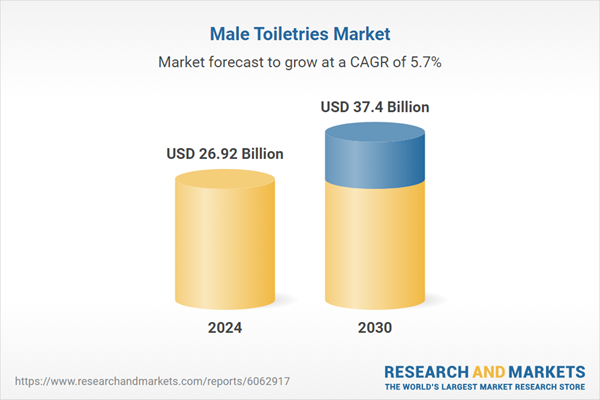Free Webex Call
The Male Toiletries Market was valued at USD 26.92 Billion in 2024, and is expected to reach USD 37.40 Billion by 2030, rising at a CAGR of 5.69%. Market growth is driven by rising male engagement in personal grooming, increased disposable incomes, and the growing influence of social media and celebrity endorsements. Key product categories include skincare, haircare, deodorants, and shaving essentials, with an increasing consumer shift toward premium, multifunctional, and clean-label offerings. Additionally, the rapid expansion of e-commerce and the emergence of direct-to-consumer (DTC) brands are transforming consumer purchasing behaviors. Sustainability, ethical sourcing, and natural ingredients are becoming core preferences among consumers, influencing brand strategies and product development. Speak directly to the analyst to clarify any post sales queries you may have.
10% Free customizationThis report comes with 10% free customization, enabling you to add data that meets your specific business needs.
Key Market Drivers
Evolving Attitudes Toward Male Grooming
The modern male consumer is increasingly attentive to personal care and appearance, challenging long-standing gender norms in the grooming industry. Social and cultural shifts, bolstered by the visibility of grooming influencers, celebrities, and online content, are encouraging men to adopt comprehensive skincare and grooming routines.According to a July 2024 study, 52% of U.S. men now use facial skincare products - up 68% from 31% in 2022. This behavior is especially pronounced among Gen Z males (ages 18-27 in 2024), where usage rose from 42% to 68% in just two years.
Urbanization, a more appearance-conscious work environment, and the mainstreaming of self-care are further fueling demand. As a result, products such as facial cleansers, moisturizers, anti-aging creams, and grooming kits tailored to specific skin and hair needs are gaining popularity. This rising awareness represents a significant opportunity for brands aiming to meet the diverse and evolving expectations of the modern male consumer.
Key Market Challenges
Intensifying Competition and Need for Differentiation
The male toiletries market is highly competitive, characterized by the presence of established global brands, emerging startups, and niche DTC players. Major companies such as Unilever, Procter & Gamble, and L’Oréal leverage their brand equity and global distribution capabilities to maintain market dominance.Simultaneously, newer entrants are challenging incumbents by offering organic, clean, and customized grooming solutions, creating a fragmented and crowded landscape. Consumers are frequently overwhelmed by the breadth of options, leading to lower brand loyalty and more fluid purchasing decisions.
To remain competitive, brands must clearly differentiate themselves through unique value propositions such as natural formulations, eco-friendly packaging, personalization via AI, or multifunctional benefits. However, maintaining innovation while managing cost competitiveness is a persistent challenge, especially for smaller brands with limited resources.
Key Market Trends
Growing Demand for Skincare and Multifunctional Products
Men's grooming habits are evolving beyond traditional hygiene essentials. There is a notable rise in demand for targeted skincare products such as cleansers, serums, moisturizers, and anti-aging treatments - particularly among younger demographics focused on wellness and long-term skin health.Moreover, male consumers increasingly seek practical, time-saving solutions, fueling demand for multifunctional products. Brands are launching all-in-one grooming solutions, including 3-in-1 shampoos, conditioners, and body washes, as well as moisturizers with SPF and beard oils that combine hydration with skincare benefits.
These products appeal to male consumers who favor simplicity, efficiency, and convenience in their grooming routines, driving innovation in the category and reshaping product portfolios across the industry.
Key Market Players
- L'Oréal S.A.
- Unilever plc
- Beiersdorf AG
- The Procter & Gamble Company
- Kao Corporation
- Shiseido Co., Ltd.
- The Estée Lauder Companies Inc.
- Coty Inc.
- Molton Brown Limited
- Edgewell Personal Care Company
Report Scope:
In this report, the Global Male Toiletries Market has been segmented into the following categories, in addition to the industry trends which have also been detailed below:Male Toiletries Market, By Product:
- Deodorants
- Haircare Products
- Skincare Products
- Shower Products
Male Toiletries Market, By Price Range:
- Premium
- Mass
Male Toiletries Market, By Sales Channel:
- Hypermarket/Supermarket
- Departmental stores
- Pharmacies
- Online
- Others
Male Toiletries Market, By Region:
- North America
- United States
- Canada
- Mexico
- Europe
- France
- United Kingdom
- Italy
- Germany
- Spain
- Asia-Pacific
- China
- Japan
- India
- South Korea
- Indonesia
- South America
- Argentina
- Colombia
- Brazil
- Middle East & Africa
- South Africa
- Saudi Arabia
- UAE
- Turkey
Competitive Landscape
Company Profiles: Detailed analysis of the major companies present in the Global Male Toiletries Market.Available Customizations:
With the given market data, the publisher offers customizations according to a company's specific needs. The following customization options are available for the report.Company Information
- Detailed analysis and profiling of additional market players (up to five).
This product will be delivered within 1-3 business days.
Table of Contents
1. Introduction
2. Research Methodology
3. Executive Summary
4. Global Male Toiletries Market Outlook
5. North America Male Toiletries Market Outlook
6. Europe Male Toiletries Market Outlook
7. Asia-Pacific Male Toiletries Market Outlook
8. Middle East & Africa Male Toiletries Market Outlook
9. South America Male Toiletries Market Outlook
10. Market Dynamics
11. Market Trends & Developments
12. Porters Five Forces Analysis
13. Competitive Landscape
Companies Mentioned
- L'Oréal S.A.
- Unilever plc
- Beiersdorf AG
- The Procter & Gamble Company
- Kao Corporation
- Shiseido Co., Ltd.
- The Estée Lauder Companies Inc.
- Coty Inc.
- Molton Brown Limited
- Edgewell Personal Care Company
Table Information
| Report Attribute | Details |
|---|---|
| No. of Pages | 181 |
| Published | April 2025 |
| Forecast Period | 2024 - 2030 |
| Estimated Market Value ( USD | $ 26.92 Billion |
| Forecasted Market Value ( USD | $ 37.4 Billion |
| Compound Annual Growth Rate | 5.6% |
| Regions Covered | Global |
| No. of Companies Mentioned | 10 |









